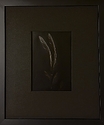Two ways to greatly reduce fiber-based print washing times .....
Reduced print washing times are one thing and one's time
spent in seeing to a thorough wash is another. As for myself
the prints can take all day as long as I have not expended
but little time in seeing to their being clean. The following
workflow requirers only two trays and some thin
polyester batting or similar material.
Prints from a very dilute one-shot fix are placed into a hold/soak
tray; each print bottom and top with separator. So far I've spent
no time washing the prints. The most is made of the hold/soak
water. The water is drained into a second tray and stirred.
The prints and separators from the first hold/soak tray
are transferred to the second. The transfer of water
and prints takes only a few minutes.
One or two additional fresh water transfers are made. Each
transfer being doubled so as to make the very most of the
least amount of water. Weather one or two the last soak
is overnight. The last transfer is made early in the day
with a short last soak following.
I call it the Alternate Two Tray Still Water Diffusion Method.
THE LEAST water way to wash. See my just previous post
this thread. Fred Picker endorsed. Dan













